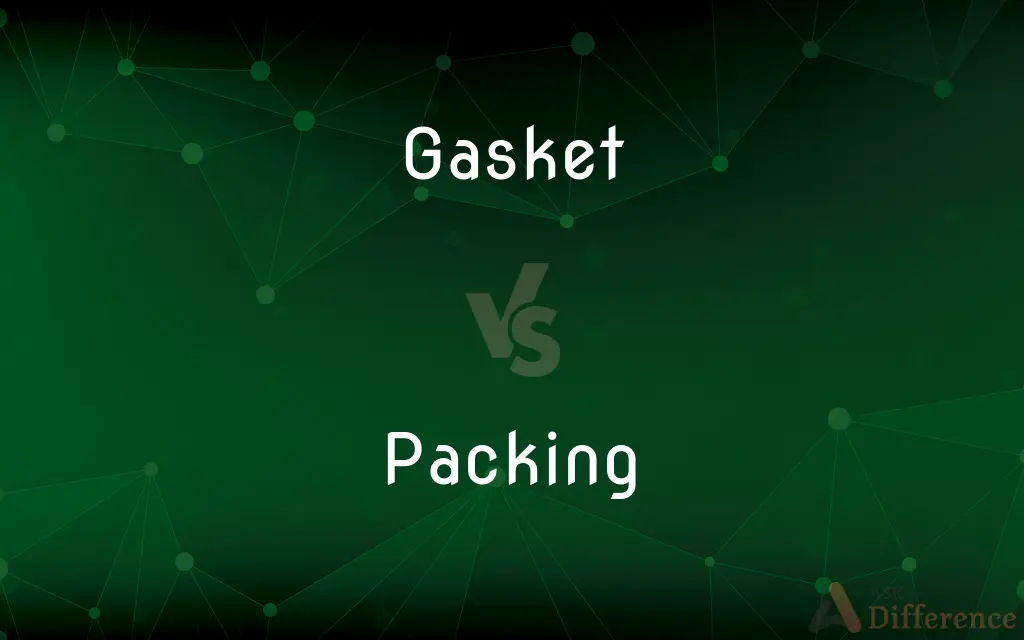Gasket vs. Packing — What's the Difference?
By Fiza Rafique & Urooj Arif — Updated on March 18, 2024
A gasket is a mechanical seal that fills the space between two or more mating surfaces, preventing leakage, while packing is a sealing material used to fill gaps and prevent leaks around movable components, such as shafts and valve stems.

Difference Between Gasket and Packing
Table of Contents
ADVERTISEMENT
Key Differences
Gaskets are designed to be placed between fixed components, such as the flanges of pipes or the head and block of an engine, to create a tight seal that prevents fluid or gas leaks under compression. They can be made from a variety of materials, including rubber, metal, or cork, depending on the application and the type of fluid or gas they need to contain. On the other hand, packing is a flexible sealing material, often made of fibrous materials, graphite, or PTFE (Teflon), which is inserted into a space (packing gland) to seal around a moving component. This is commonly seen in pumps and valves where a shaft or stem moves through the seal area.
While gaskets serve to seal the space between stationary components that are bolted or otherwise secured together, packing is used where there needs to be a seal around a moving part, allowing for movement without leakage. The choice between using a gasket or packing depends on the nature of the assembly, whether it involves stationary parts or parts that require motion.
In applications, gaskets are critical for maintaining the integrity of a closed system, such as in engines, pipelines, and boilers. Packing, however, is essential for applications where dynamic sealing is necessary, as in faucets, pumps, and valves, ensuring that fluids can be controlled without escaping the mechanism.
Despite their differences, both gaskets and packing play crucial roles in fluid and gas control technologies. They are selected based on factors such as pressure, temperature, chemical compatibility, and the presence of motion in the sealing application. The effectiveness of each depends on correct material selection, design, and installation to meet the specific needs of the application.
While gaskets are used to seal between stationary parts to prevent leakage, packing is used to allow for controlled movement of parts while maintaining a seal, with each serving a unique and vital function in various industrial and mechanical contexts.
ADVERTISEMENT
Comparison Chart
Purpose
Seals between stationary surfaces.
Seals around moving parts.
Application
Used in pipes, engines, and boilers.
Used in pumps, valves, and faucets.
Material
Rubber, metal, cork, etc.
Fibrous materials, graphite, PTFE.
Function
Prevents leaks in static assemblies.
Allows for movement without leakage.
Installation Area
Between two or more mating surfaces.
Around shafts, stems, and movable components.
Compare with Definitions
Gasket
Made from various materials for different uses.
A silicone gasket was used for its heat resistance.
Packing
A sealing material for gaps around movable components.
The valve's packing was replaced to stop the leak.
Gasket
Requires precise installation for effectiveness.
Installing the gasket correctly ensured there were no leaks.
Packing
Made from flexible materials to allow movement.
Graphite packing was chosen for its durability and flexibility.
Gasket
A seal preventing leaks between stationary parts.
The engine's performance improved after replacing the worn-out gasket.
Packing
Critical for operational efficiency in machinery.
Regular maintenance of the packing extends equipment life.
Gasket
Designed for specific pressure and temperature.
The boiler gasket can withstand high temperatures and pressures.
Packing
Adjusted to control leakage and allow operation.
Adjusting the packing gland stopped the drip from the shaft.
Gasket
Essential for maintaining system integrity.
Proper gasket selection is crucial for pipeline safety.
Packing
Often used in dynamic sealing applications.
Pump packing needs regular inspection to ensure reliability.
Gasket
A material which may be clamped between faces and acts as a static seal. Gaskets may be cut, formed, or molded to the desired configuration.
Packing
The act or process of one that packs.
Gasket
A gasket is a mechanical seal which fills the space between two or more mating surfaces, generally to prevent leakage from or into the joined objects while under compression. Given the potential cost and safety implications of faulty or leaking gaskets, it is critical that the correct gasket material is selected to fit the needs of the application.
Packing
The processing and packaging of manufactured products, especially food products.
Gasket
Any of a wide variety of seals or packings used between matched machine parts or around pipe joints to prevent the escape of a gas or fluid.
Packing
A material used to prevent leakage or seepage, as around a pipe joint.
Gasket
(Nautical) A cord or canvas strap used to secure a furled sail to a yard, boom, or gaff.
Packing
The insertion of gauze or other material into a body cavity or wound for therapeutic purposes.
Gasket
(sailing) A length of rope or canvas band used for reefing a sail, or holding a stowed sail in place.
Packing
The material so used; a pack.
Gasket
(mechanics) Any mechanical seal that serves to fill the space between two objects, generally to prevent leakage between the two objects while under compression.
Packing
Present participle of pack
Gasket
Any of a wide variety of seals or packings used between matched machine parts or around pipe joints to prevent the escape of a gas or fluid.
Packing
The action of the verb.
Gasket
To fit a gasket
Packing
The action of putting things together, especially of putting clothes into a suitcase for a journey.
Gasket
To seal wth a gasket
Packing
The spatial arrangement of objects, items or constituent parts.
Gasket
A line or band used to lash a furled sail securely. Sea gaskets are common lines; harbor gaskets are plaited and decorated lines or bands. Called also casket.
Packing
The gathering of birds, animals etc. into a pack.
Gasket
The plaited hemp used for packing a piston, as of the steam engine and its pumps.
Packing
(rugby) The forming of players into a scrum.
Gasket
Seal consisting of a ring for packing pistons or sealing a pipe joint
Packing
As a concrete noun.
Packing
Material used to fill in the space around something, especially to make a piston etc. watertight or airtight.
Packing
Material used to wrap a product for sale etc.; packaging.
Packing
A fee charged to cover the costs of packaging.
Packing
Special material used to fill containers or vessels for certain chemically related applications.
Packing in a packed bed, or a column such as a distillation column or a chromatography column
Packing
Clipping of meatpacking
Packing
The act or process of one who packs.
Packing
Any material used to pack, fill up, or make close.
Packing
Same as Filling.
Packing
A trick; collusion.
Packing
Any material used especially to protect something
Packing
The enclosure of something in a package or box
Packing
Carrying something in a pack on the back;
The backpacking of oxygen is essential for astronauts
Common Curiosities
Can gaskets be used for moving parts?
No, gaskets are designed for stationary parts. Packing is used for sealing around moving parts.
Are gaskets and packing made from the same materials?
While there can be some overlap in materials, gaskets and packing are generally made from materials best suited to their specific sealing roles, with gaskets often being more rigid and packing more flexible.
What is packing in mechanical terms?
Packing is a sealing material used to prevent leaks around movable components, such as valves and pump shafts, while allowing them to function properly.
Can packing be adjusted?
Yes, packing can often be adjusted to control leakage around the moving component it seals.
Do gaskets work under high pressure?
Yes, certain gasket materials are designed to withstand high pressures, making them suitable for a variety of industrial applications.
What role does chemical compatibility play in selecting gaskets and packing?
Chemical compatibility is crucial to prevent material degradation, ensuring the longevity and effectiveness of the seal.
Is there a universal type of gasket or packing that works for all applications?
No, due to varying operational conditions and requirements, there is no one-size-fits-all solution. Selection must be based on specific application needs.
What is a gasket used for?
A gasket is used to seal the space between two or more stationary surfaces to prevent leaks of fluids or gases.
How often should gaskets and packing be replaced?
Replacement depends on wear, application conditions, and the materials used. Regular inspection can help determine the need for replacement.
Why is packing necessary in valves and pumps?
Packing prevents leaks of fluids or gases while allowing the valve stems or pump shafts to move, ensuring the device operates efficiently and safely.
How do I choose between a gasket and packing?
The choice depends on the application: use gaskets for stationary surfaces and packing for areas with moving parts.
How does movement affect the choice between gasket and packing?
Movement is a key consideration; stationary joints require gaskets for sealing, whereas joints with movement necessitate the use of packing to accommodate motion without leaking.
What happens if a gasket fails?
Failure of a gasket can lead to leaks, system inefficiency, or in severe cases, system failure, highlighting the importance of correct selection and installation.
How does temperature affect gasket and packing choice?
Temperature is a critical factor; materials must be chosen based on their ability to maintain their sealing properties under the operational temperature range.
Can a gasket be used more than once?
Generally, gaskets are designed for single use, as disassembly usually compromises their integrity.
Share Your Discovery

Previous Comparison
Neoprene vs. Elastomer
Next Comparison
Mexican vs. BeanerAuthor Spotlight
Written by
Fiza RafiqueFiza Rafique is a skilled content writer at AskDifference.com, where she meticulously refines and enhances written pieces. Drawing from her vast editorial expertise, Fiza ensures clarity, accuracy, and precision in every article. Passionate about language, she continually seeks to elevate the quality of content for readers worldwide.
Co-written by
Urooj ArifUrooj is a skilled content writer at Ask Difference, known for her exceptional ability to simplify complex topics into engaging and informative content. With a passion for research and a flair for clear, concise writing, she consistently delivers articles that resonate with our diverse audience.













































